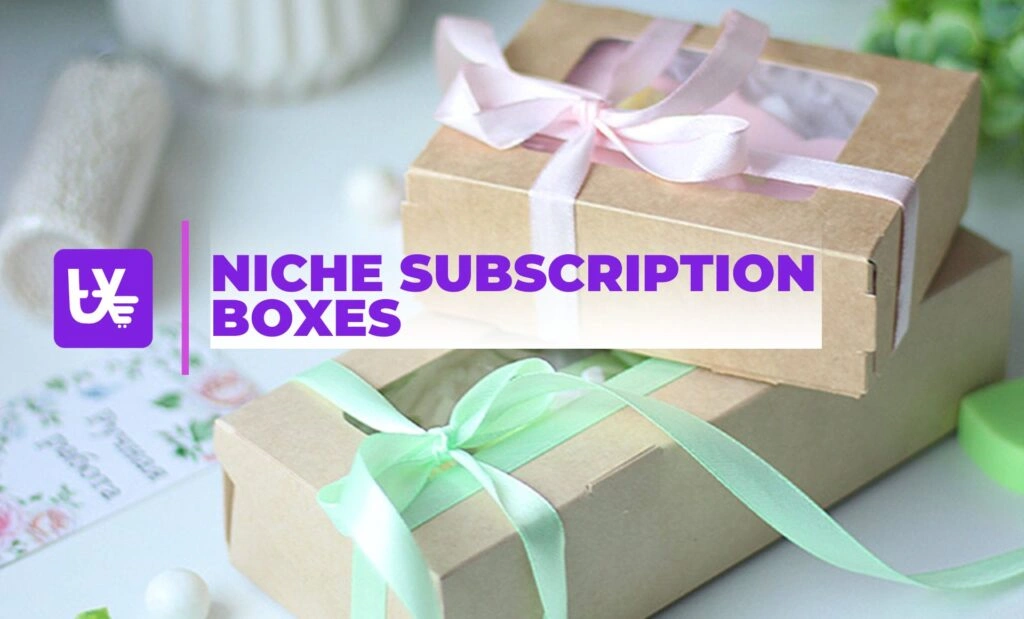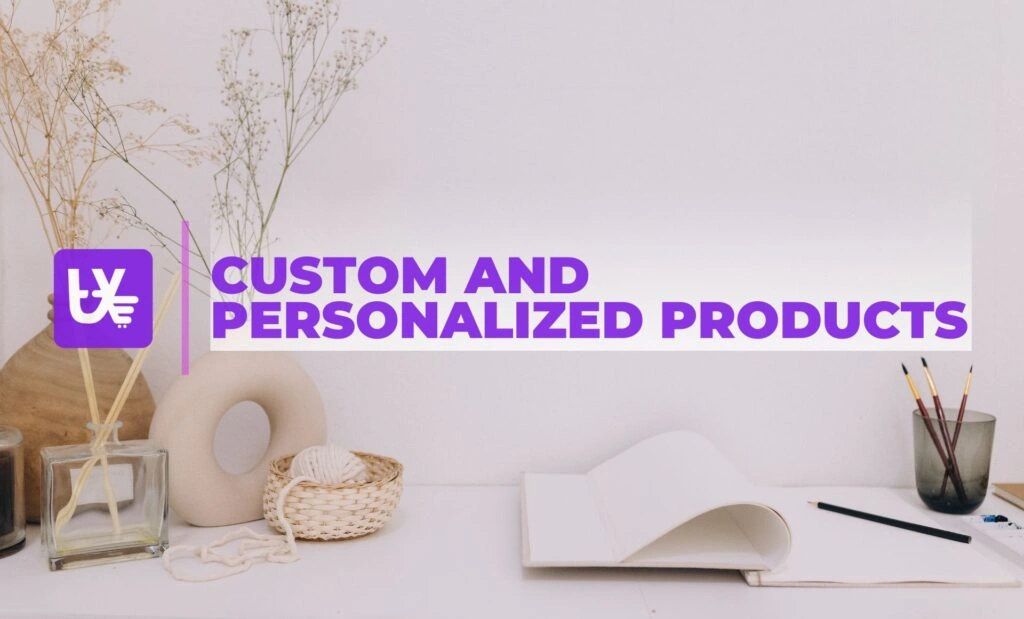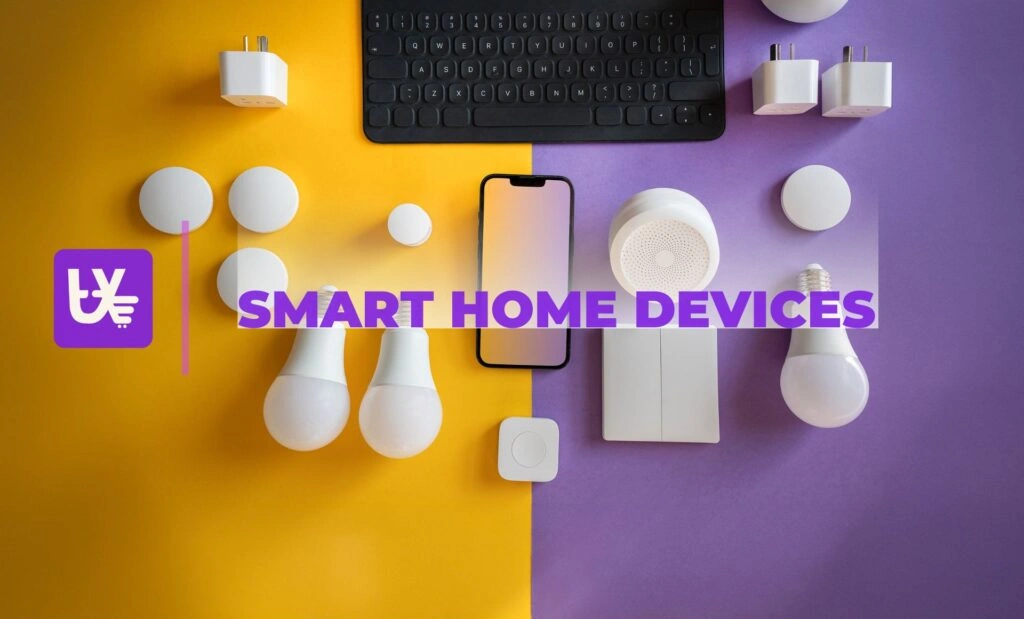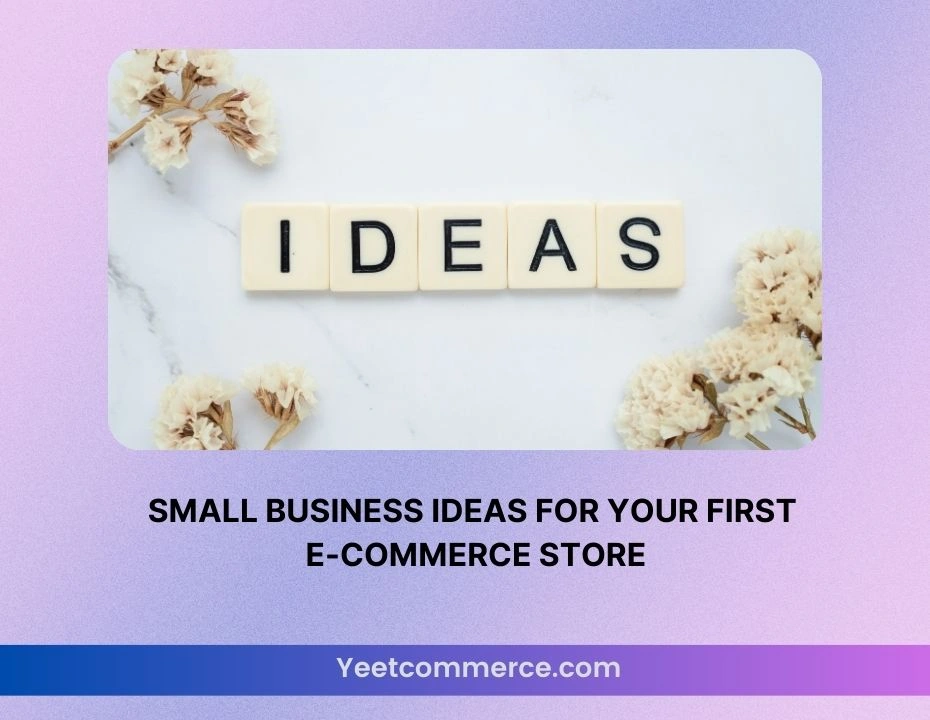Dream of turning your passion into a profitable online business? Small business ideas like starting an eCommerce store can be an exciting and rewarding venture. With the right idea and a bit of creativity, you can build a thriving online empire.
In this guide, we’ll explore some of the top small business ideas that are perfect for your first eCommerce store. Whether you’re a seasoned entrepreneur or just starting out, these ideas offer unique opportunities to tap into growing markets and connect with eager customers.
So, let’s get started and discover the perfect eCommerce venture to suit your interests and goals!
Choosing Your Niche: How to Find the Perfect Small Business Idea for Your eCommerce Store
Starting your first eCommerce store can be both exciting and overwhelming. With countless small business ideas to choose from, how do you find the one that’s perfect for you? The right niche can set the foundation for your success, so it’s crucial to make a thoughtful choice. Let’s dive into the process of finding that golden idea that aligns with your passions, strengths, and market demand.
Identify Your Interests and Passions
When brainstorming small business ideas, first start by considering what excites you. For example, what are your hobbies? Furthermore, what topics do you find yourself researching just for fun? Your interests can be a strong indicator of where you should focus your eCommerce efforts. Additionally, when you choose a niche you’re passionate about, running your business will feel less like work and more like a fulfilling pursuit. Moreover, your enthusiasm will shine through in your marketing, helping you connect with customers on a deeper level.
Top 10 ideas for small business in 2024
1. Niche Subscription Boxes: Dive deep into specific interests with hyper-targeted subscription boxes that cater to enthusiasts often overlooked by mainstream options. Imagine a subscription for “Vegan Keto Snacks,” meticulously curated with low-carb, plant-based treats that not only meet dietary restrictions but also introduce rare and innovative products. Or, consider “Artisan Tea Blends from Rare Regions,” featuring hand picked leaves from remote locales, each box delivering a unique sensory experience and stories behind the teas. By focusing on these specific communities, you can build a devoted customer base that feels uniquely catered to.

_____________________________________
2. Sustainable and Eco-Friendly Products: Capture the hearts of eco-conscious consumers with products that tell a compelling environmental story. Offer “Upcycled Ocean Plastic Sunglasses,” crafted from recycled ocean plastics, each pair not only reducing waste but also featuring unique, one-of-a-kind designs due to the varying textures and colors of reclaimed materials. Alternatively, “Biodegradable Home Cleaning Kits” could include plant-based, compostable cleaners paired with refillable containers, merging eco-friendly practices with convenience and effectiveness, making every purchase a step towards a greener planet.

______________________________
3. Custom and Personalized Products: Transform the shopping experience with real-time customization tools that let customers shape their products to their exact tastes. For instance, “3D Custom-Printed Jewelry” allows users to interactively design their own pieces, previewing adjustments in real-time before finalizing their purchase. Imagine “Personalized Home Decor” where customers upload photos for hand-painted family portraits or select specific landmarks for custom maps, creating cherished items that reflect personal stories and preferences in every detail.

_____________________________________
4. Health and Wellness Products: Address the growing demand for personalized wellness solutions with products that cater to specific health needs. Offer “Adaptogenic Wellness Blends” formulated with adaptogens like ashwagandha and rhodiola, designed for stress management and mental clarity. Provide “Personalized Vitamin Packs” tailored to individual health data, optimizing nutrient intake based on personal health metrics and goals. Explore “Mindfulness Tech” with advanced wearable devices that integrate biofeedback and guided meditation features, blending technology with wellness to support holistic health.

_______________________________________________
5. Pet Products and Accessories: Elevate pet care with innovative and luxurious products that cater to both pets and their owners. Consider “Custom Orthopedic Pet Beds” designed for senior pets with joint issues, featuring memory foam and customizable covers for ultimate comfort and style. Offer “Pet DNA Kits” that not only provide breed-specific care recommendations but also offer personalized nutrition plans based on the pet’s genetic profile. Expand into eco-friendly pet products with biodegradable toys and organic food, combining luxury and sustainability for discerning pet owners.

________________________________________________________
6. Home Office Equipment: Revolutionize home workspaces with products that blend ergonomic design with aesthetic appeal. Offer “Designer Ergonomic Office Chairs” that not only provide superior comfort but also complement modern home decor with sleek, stylish designs. Create “Modular Office Setups” allowing users to easily reconfigure their workspace based on task requirements, and consider “Remote Work Essentials Kits” with items like noise-canceling headphones and blue light-blocking glasses, designed to enhance productivity and comfort for remote workers.

________________________________________________
7. DIY Craft Kits: Engage both novice and experienced crafters with comprehensive kits that go beyond traditional offerings. Provide “Masterclass Craft Kits” that include not only high-quality materials but also access to online workshops led by industry experts, making crafting both accessible and educational. Develop “Eco-Friendly DIY Kits” using sustainable materials like recycled paper and natural dyes, appealing to environmentally conscious creators. Explore “Cultural Craft Kits” featuring traditional crafting techniques from different cultures, offering a unique, hands-on learning experience and a connection to global artistry.

_______________________________________________
8. Smart Home Devices: Innovate with smart home technology tailored for niche applications. Offer “Smart Pet Care Devices” like automatic feeders and interactive cameras that allow pet owners to monitor and engage with their pets remotely, enhancing pet care while owners are away. Create “Energy-Saving Smart Home Kits” that include smart plugs, thermostats, and lighting solutions designed to optimize energy usage and reduce bills. Develop “Voice-Controlled Home Automation for Accessibility” systems that enhance the independence of individuals with disabilities, integrating smart technology to make daily tasks easier and more manageable.

_________________________________________________
9. Digital Products and Online Courses: Capture emerging digital trends with offerings tailored to niche interests. Develop “Digital Detox Programs” that provide structured plans and tools for reducing screen time, promoting healthier digital habits. Create “Augmented Reality (AR) Design Courses” for creatives eager to delve into AR, providing cutting-edge education and practical applications in this growing field. Offer “Printable Wellness Journals” designed to address specific mental health needs, such as anxiety or gratitude, featuring customizable layouts and prompts to support personal growth and well-being.

_____________________________________________
10. Luxury and High-End Products: Craft exclusive, high-end offerings that emphasize personalization and prestige. Provide “Bespoke Fashion” where garments are tailored to the exact measurements and style preferences of clients, featuring luxurious fabrics and unique design elements. Offer “Limited Edition High-Tech Gadgets” produced in small quantities with premium materials, combining cutting-edge technology with exclusivity. Create “Luxury Travel Accessories” like hand-stitched leather passport holders with RFID protection, merging elegant design with practical security for the discerning traveler.

Research Market Demand and Competition
Once you have a list of potential niches based on your interests, next, it’s time to validate them by researching market demand and competition. To begin with, start by analyzing search trends and customer interest. Tools like Google Trends or keyword planners can help you see how popular your chosen niche is over time. Ideally, look for niches that have consistent or growing interest—this indicates a stable or expanding market, which is ideal for your first eCommerce store.
However, don’t stop there! Additionally, check out your potential competitors. For instance, are there many well-established players in the niche? If so, the market might be saturated, making it challenging for a newcomer to stand out. Conversely, if there are only a few competitors or none at all, this could be a red flag indicating low demand. Ultimately, the sweet spot is finding a niche with enough demand to support your business but not so much competition that you’ll struggle to make your mark.
Consider Profit Margins and Scalability
It’s easy to get excited about a niche you’re passionate about, but however, don’t forget to consider the financial side of things. When evaluating small business ideas, also think about the potential profit margins. Some products have higher margins than others, which can make a significant difference in your bottom line. For instance, digital products like eBooks or online courses often have higher profit margins because there are no shipping or inventory costs. In contrast, physical products might require more upfront investment in inventory, warehousing, and shipping.
Moreover, scalability is another crucial factor. Ask yourself, can your business grow easily? Some niches lend themselves to expansion more than others. For example, if you start with a line of eco-friendly kitchenware, you could potentially expand into other sustainable home products as your business grows. Ultimately, choosing a niche with room for growth ensures that your small business ideas have the potential to evolve and flourish over time.
Test Your Ideas with a Minimum Viable Product (MVP)
Before fully committing to a niche, it’s wise to test your small business ideas with a Minimum Viable Product (MVP). Essentially, an MVP is a basic version of your product that allows you to gauge customer interest without a significant upfront investment. For example, this could be as simple as a small batch of products or a landing page collecting emails from interested customers.
Furthermore, testing your niche with an MVP gives you valuable insights into how your target audience will respond. Subsequently, you can use this feedback to tweak your product offerings, marketing strategies, and even your niche itself. If your MVP resonates with customers, you know you’re on the right track. Conversely, if not, you can pivot without losing too much time or money. Ultimately, this approach minimizes risk and helps ensure your first eCommerce venture is set up for success.
Market Research: Tools and Tips for Validating Your Business Idea Online
When you’re bubbling with excitement about your small business ideas, it’s tempting to jump straight into launching your eCommerce store. But hold up! Before you dive in, you need to ensure there’s a market for your product. That’s where market research comes in. Validating your business idea online can save you time, money, and a whole lot of stress. So, let’s explore the essential tools and tips that’ll help you confidently move forward with your chosen niche.
1. Harness the Power of Google Trends
Google Trends is like a crystal ball for your business ideas. It lets you see what people are searching for, how interest in specific topics has changed over time, and whether your small business ideas are part of a growing trend or a fading fad. By simply typing in your potential niche or product, you can gauge its popularity and even identify seasonal trends. If your idea shows a steady or upward trend, that’s a great sign. But if it’s on a downward slope, it might be time to rethink or tweak your approach.
For example, if you’re considering selling eco-friendly pet products, search for related terms like “sustainable pet supplies” or “eco-friendly pet toys.” A consistent or rising trend suggests there’s a solid interest, which means your idea has legs to stand on. Google Trends is especially handy when comparing multiple niches, helping you choose the one with the most potential.
2. Dive Deep with Keyword Research Tools
Keyword research is the backbone of validating your eCommerce idea. For this purpose, tools like Ahrefs, SEMrush, or even Google’s Keyword Planner can provide a wealth of information about what your potential customers are searching for online. Specifically, these tools allow you to see search volume, competition, and keyword difficulty, giving you insights into how saturated or promising a market is.
When using these tools, try to look for keywords with high search volume but relatively low competition. Generally, these sweet spots indicate that there’s demand for your product, but not so much competition that you’ll be fighting an uphill battle. For instance, if you’re thinking about starting an online store selling DIY craft kits, you might find that “DIY craft kits for beginners” has a high search volume but moderate competition. Therefore, this could signal an opportunity to carve out your niche.
3. Analyze Competitors to Find Your Edge
Knowing your competitors is crucial to validating your small business ideas. Start by identifying who the major players are in your chosen niche. Visit their websites, sign up for their newsletters, and even make a purchase to understand their customer experience. What are they doing well? Where are the gaps? By analyzing your competition, you can spot opportunities to differentiate your eCommerce store.
Tools like SimilarWeb and SpyFu can help you dig deeper into competitor analysis. These platforms allow you to see where your competitors are getting their traffic from, what keywords they’re ranking for, and even their top-performing products. Use this data to refine your business idea and offer something unique that fills a gap in the market.
For example, if you discover that all your competitors are offering generic home office equipment, you might decide to specialize in ergonomic chairs designed specifically for gamers. By finding a niche within a niche, you can stand out in a crowded market.
4. Test Your Idea with Audience Feedback
One of the best ways to validate your business idea is by getting direct feedback from your potential customers. Social media platforms like Facebook, Instagram, and Reddit are goldmines for gauging interest in your niche. You can join relevant groups, participate in discussions, and even run polls to see what people think about your product idea.
Another effective strategy is to create a landing page for your product before it’s even launched. Include a brief description, some compelling images, and a call-to-action for visitors to sign up for updates or pre-orders. If people are willing to give you their email address, that’s a strong indicator that there’s interest in your product. Plus, you’ll have a ready-made audience when you’re ready to launch.
Crowdfunding platforms like Kickstarter or Indiegogo are also excellent for testing the waters. If your small business idea resonates with backers, you’ll not only validate your concept but also raise funds to kickstart your venture. It’s a win-win!
5. Keep an Eye on Social Media Trends
Social media isn’t just for selfies and memes—it’s a powerful tool for validating small business ideas. Platforms like Instagram, TikTok, and Pinterest are trend incubators where you can see what’s gaining traction in real-time. By following influencers and popular hashtags in your niche, you can spot emerging trends that could inspire your product offerings.
For example, if you notice that a particular type of DIY craft is going viral on TikTok, that’s a signal that there’s a growing market for it. You can ride the wave by offering related products or tutorials. Staying on top of social media trends ensures that your eCommerce store remains relevant and appealing to your target audience.
Building Your Brand: Essential Branding Steps for a New eCommerce Business
When it comes to launching your first eCommerce store, branding is everything. Your brand is more than just a logo or a catchy tagline—it’s the identity that will set you apart in the crowded online marketplace. Nailing down your brand is crucial to turning your small business ideas into a successful and memorable venture. In this section, we’ll walk you through the essential steps to building a brand that resonates with your target audience and leaves a lasting impression.
1.Define Your Brand’s Core Values and Mission
Before you start designing logos or picking colors, take a step back and think about what your brand stands for. Your core values and mission are the foundation of your brand. They’re what you want your business to be known for, the principles that guide your decisions, and the promises you make to your customers.
As Simon Sinek once said, “People don’t buy what you do; they buy why you do it” (Sinek, 2009). This quote underscores the importance of having a clear mission that resonates with your audience.
Start by asking yourself a few key questions: What inspired your small business ideas? What problem are you solving? How do you want to make your customers feel? For instance, if your eCommerce store will sell eco-friendly products, your core values might include sustainability, transparency, and social responsibility. Your mission could be to provide high-quality, sustainable products that help customers reduce their environmental impact.
Once you’ve defined your values and mission, make sure they’re reflected in everything you do—from your product descriptions to your customer service. This consistency will help build trust and loyalty among your customers, setting you up for long-term success.
2. Create a Memorable Brand Name and Logo
Your brand name and logo are often the first things people notice about your business, so they need to make a strong impression. A great brand name should be easy to remember, unique, and reflective of your small business ideas. It should give potential customers a hint of what you offer, while also being flexible enough to grow with your business.
As Jeff Bezos, the founder of Amazon, famously said, “Your brand is what other people say about you when you’re not in the room” (Bezos, n.d.). This highlights the importance of choosing a name and logo that leave a lasting, positive impression.
When brainstorming names, think about your target audience and what will resonate with them. Use a thesaurus, play with words, or even combine terms that reflect your brand’s values. Once you have a shortlist, check if the domain name is available and do a quick search to ensure there aren’t any similar names out there.
After choosing a name, it’s time to design your logo. Your logo should be simple, versatile, and aligned with your brand’s personality. You don’t need to be a design expert to create a great logo—there are plenty of online tools and freelance designers who can help you bring your vision to life. Whether you’re aiming for a sleek, modern look or a fun, playful vibe, your logo should be a visual representation of your brand’s identity.
3.Establish Your Brand’s Voice and Messaging
Your brand voice is how you communicate with your audience, and it’s a big part of what makes your brand unique. Are you casual and friendly, or professional and authoritative? Do you use humor, or are you more serious? Defining your brand voice will help you create consistent messaging across all your channels, from your website and social media to customer emails and advertisements.
As David Ogilvy, often hailed as the “Father of Advertising,” said, “Every advertisement should be thought of as a contribution to the complex symbol which is the brand image” (Ogilvy, 1983). This emphasizes the importance of consistent brand messaging in shaping how your audience perceives your business.
Think about your target audience and how they speak—your brand voice should reflect that. If you’re selling trendy fashion accessories to young adults, a fun, energetic voice might be the way to go. On the other hand, if your eCommerce store focuses on health and wellness products, a calming and informative tone might be more appropriate.
Once you’ve nailed down your brand voice, apply it to all your messaging. This includes your product descriptions, blog posts, social media captions, and even your customer service interactions. Consistent messaging helps build a strong brand identity and ensures that customers know what to expect when they interact with your business.
4. Design a Cohesive Visual Identity
Your visual identity is how your brand looks and feels to your audience. It includes everything from your color palette and typography to your website design and packaging. A cohesive visual identity not only makes your brand look professional but also creates a recognizable and memorable experience for your customers.
Start by choosing a color palette that reflects your brand’s personality. For example, bright, bold colors might be great for a fun, youthful brand, while muted, earthy tones could work well for a more sophisticated, eco-conscious business. Stick to a consistent color scheme across all your branding materials to create a unified look.
Next, select typography that complements your brand voice. Whether you go for modern sans-serif fonts or classic serif typefaces, make sure your text is easy to read and aligns with your brand’s overall aesthetic.
Finally, apply your visual identity consistently across all touchpoints. Your website, social media profiles, email newsletters, and even your packaging should all look like they belong to the same brand. This visual consistency helps reinforce your brand identity and makes your business more memorable to customers.
5.Build Brand Awareness with Consistent Marketing
Once you’ve established your brand identity, it’s time to spread the word. Building brand awareness is key to growing your eCommerce business, and it requires consistent, strategic marketing efforts. Use social media, email marketing, content creation, and paid advertising to get your brand in front of potential customers.
As Seth Godin, a marketing expert, famously said, “Marketing is no longer about the stuff that you make, but about the stories you tell” (Godin, 2012). This highlights the importance of using your marketing efforts to share your brand’s story and connect with your audience.
Start by creating a content calendar that outlines your marketing activities for the next few months. This will help you stay organized and ensure that your messaging remains consistent. Share your brand’s story, values, and mission through blog posts, social media updates, and newsletters. Engage with your audience by responding to comments, answering questions, and fostering a community around your brand.
If you have the budget, consider running paid ads on platforms like Google or Facebook. Targeted ads can help you reach new audiences and drive traffic to your eCommerce store. Just make sure your ads align with your brand’s identity and resonate with your target audience.
Launching with YeetCommerce: How to Set Up Your First Store Using YeetCommerce
You’ve got your brilliant small business idea, your branding is on point. Now it’s time to bring your vision to life. Enter YeetCommerce—the ultimate platform to launch your first eCommerce store with ease and style. In this section, we’ll guide you through setting up your store step-by-step. So you can start selling your amazing products to the world.
1. Getting Started: Sign Up and Choose Your Perfect Plan
Starting your eCommerce journey with YeetCommerce is as simple as it gets. Head over to their website and click that shiny “Get Started” button. You’ll be prompted to create an account by entering your email, creating a password, and providing a few basic details about your small business idea.
YeetCommerce offers a variety of plans tailored to different business needs and budgets. Whether you’re testing the waters with a handful of products or planning to conquer the online marketplace. There’s a plan for you. Take a moment to review the features of each plan, and pick the one that aligns best with your goals and current stage.
Worried about commitment? YeetCommerce has got you covered with a free trial period. This allows you to explore the platform’s features and ensure it’s the right fit for your budding eCommerce store before investing your hard-earned cash.
For complete guidance, here is the link to the guide where you can learn more about Yeetcommerce and how to create your eCommerce store.https://yeetcommerce.com/guide/yeetcommerce-guide-how-to-start-a-ecommerce-business-without-money/
2. Designing Your Store: Choose and Customize Your Theme
Now comes the fun part—designing your online storefront! YeetCommerce boasts a vast library of professionally designed themes that cater to various industries and aesthetics. Browse through the collection and select a theme that resonates with your brand’s personality and appeals to your target audience.
Once you’ve picked the perfect theme, it’s time to make it uniquely yours. YeetCommerce‘s intuitive drag-and-drop editor lets you customize every aspect of your store without any coding knowledge. Adjust colors to match your branding. Choose fonts that convey your brand voice, and arrange layout elements to create a seamless shopping experience.
Don’t forget to add your brand’s logo and high-quality images of your products. Visual appeal plays a significant role in attracting and retaining customers, so make sure your store looks polished and inviting. Remember, your eCommerce store is the digital face of your small business idea, so let your creativity shine!
3. Adding Products: Showcase What Makes Your Business Special
With your store’s design in place, it’s time to fill those virtual shelves with your fantastic products. Navigate to the “Products” section in your YeetCommerce dashboard and click “Add Product.” You’ll be prompted to enter essential details like product name, description, price, and inventory levels.
Craft compelling product descriptions that highlight the features and benefits of your offerings. Use persuasive language and storytelling to connect with your customers and showcase what sets your small business ideas apart from the competition. Including relevant keywords can also boost your store’s visibility in search engines.
High-quality product images are a must. Invest time in photographing your products from various angles and in different settings. Clear and attractive images help customers visualize using your products, increasing the likelihood of making a purchase. YeetCommerce supports multiple images per product, so don’t be shy about showcasing every detail.
If you offer variants like different sizes, colors, or materials, YeetCommerce makes it easy to add these options seamlessly. This ensures your customers have a smooth and enjoyable shopping experience, encouraging them to come back for more.
Learn more about adding products by following this link: https://yeetcommerce.com/guide/ultimate-guide-to-ecommerce-product-and-category-management-on-yeetcommerce/
4. Setting Up Payments and Shipping: Making Transactions Smooth and Secure
A crucial part of your eCommerce store setup is configuring payment and shipping options. YeetCommerce integrates with a multitude of payment gateways, including PayPal, Stripe, and major credit cards. Providing your customers with secure and convenient ways to pay. Simply choose the payment methods that suit your business and follow the straightforward setup instructions.
Next up is setting your shipping rates and methods. YeetCommerce allows you to customize shipping options based on weight, location, and delivery speed. You can offer flat-rate shipping, real-time carrier rates, or even free shipping to entice customers. Clearly defined and reasonable shipping options can significantly enhance customer satisfaction and reduce cart abandonment rates.
Don’t forget to configure your tax settings according to your local regulations. YeetCommerce simplifies this process by providing tools to automatically calculate taxes based on your location and the destinations you ship to.
5. Launching and Promoting Your Store: Let the World Know You’re Open for Business
With all the essentials in place, it’s time to unveil your eCommerce store to the world! Before hitting that launch button, preview your store thoroughly to ensure everything looks and functions perfectly. Test your navigation, product pages, cart, and checkout process to catch any glitches before your customers do.
Once you’re satisfied, go ahead and make your store live. But don’t stop there—now it’s time to promote your small business idea and attract customers. Utilize YeetCommerce’s built-in marketing tools to optimize your store for search engines, create discount codes, and set up email marketing campaigns.
Leverage social media platforms to showcase your products and engage with potential customers. Share behind-the-scenes content, customer testimonials, and exciting updates to build a loyal community around your brand. Consider running targeted ads to reach a broader audience and drive traffic to your store.
Monitor your store’s performance using YeetCommerce’s analytics dashboard. Keep an eye on sales figures, customer behavior, and traffic sources to make informed decisions and continuously improve your business strategy.
Conclusion:
Choosing the right niche, building a strong brand, conducting thorough market research, and using a user-friendly platform like YeetCommerce are all critical steps in launching a successful eCommerce store. Aligning your business ideas with your passions. Validating them through research and testing, and establishing a consistent brand identity will set the foundation for long-term success. With tools and support from platforms like YeetCommerce, bringing your ideas to life becomes a smooth and enjoyable process. Ensuring your venture thrives in the competitive online marketplace.


















